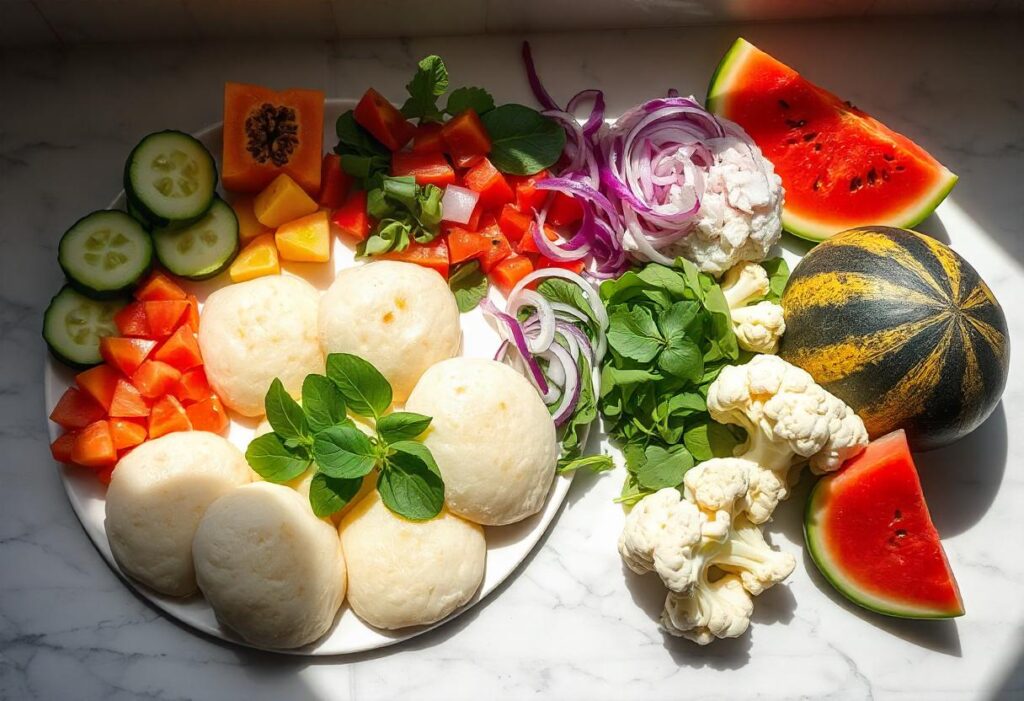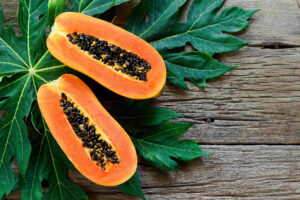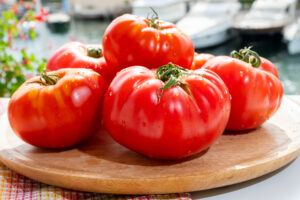In This Article
Toggle
In This Article
ToggleIndian cuisine is renowned for its rich flavors and diverse dishes. While many traditional recipes are indulgent, there are plenty of low-calorie options that are both delicious and nutritious. These foods not only help manage weight but also provide essential nutrients for maintaining a healthy lifestyle.
The beauty of Indian food lies in its use of fresh, wholesome ingredients like vegetables, legumes, and grains, which are naturally low in calories yet packed with essential nutrients.
Additionally, Indian cooking employs a wide range of spices that not only add flavor but also offer numerous health benefits.
From hearty dals and light vegetable curries to refreshing salads and wholesome snacks, Indian cuisine has something for everyone looking to eat smart and feel good. These low-calorie dishes are the perfect way to enjoy vibrant flavors while staying on track with your health goals.
Here’s a comprehensive guide to some of the best low-calorie Indian foods that can be incorporated into your daily diet.
Why Choose Low-Calorie Foods?
Low-calorie foods are ideal for those looking to lose weight, maintain a healthy weight, or simply adopt a more balanced diet. They provide essential nutrients without excessive calories, helping to control portion sizes while keeping you satiated.
Additionally, such foods often have high water content, fiber, and essential vitamins, which contribute to better digestion and overall health.
Top Low-Calorie Indian Foods
Below are some Indian foods low in calories.
1. Papaya
Papaya is a orange-yellow fruit found in tropical regions.
A small (157 grams) of papaya contains only about 68 calories, making it an excellent choice for those looking to reduce calorie intake.
Papaya also contains essential nutrients like magnesium, potassium, copper, vitamin A, C, and folate.
Enjoy it as a snack, in smoothies, or salads for a refreshing and healthy treat.
2. Sprouts Salad
Sprouts, particularly from moong beans, are packed with nutrients and low in calories.
Mung beans have been used in traditional Chinese medicine for its ability to detoxify the body, improve mental well-being, relieve heat stroke, and ease digestive issues.
Sprouted moong beans are light yet nutritious, with just 30 calories per 100 grams. Adding cucumber, tomato, and a squeeze of lemon for a refreshing sprouts salad brings the total to around 50-60 calories—healthy, flavorful, and low in calories!
Sprouts are not only low in calories but are also rich in protein and antioxidants, making them an excellent, nutritious snack or side dish.
In fact, sprouting has been shown to significantly increase the antioxidant content and antioxidant activity of mung beans.
Additionally, mung beans contain phytic acid, an antinutrient that is reduced by 76% when sprouted. This reduction enhances digestion and improves the absorption of important nutrients like iron and zinc, increasing their absorption by 2.4 and 3 times, respectively.
3. Idli
Idli, a steamed rice and lentil cake, is a staple South Indian breakfast option.
Low in calories (49 calories per idli) and easy to digest, it is perfect for those aiming to keep their calorie intake in check. Pair it with coconut chutney or sambar for a complete meal.
A serving of 4 idlis provides around 196 calories, which is considered low for a meal, as most meals typically range between 300 to 600+ calories.
They are also a decent source of essential minerals and B-vitamins like thiamine and folate.
4. Buttermilk (Chaas)
Buttermilk is a cooling drink made by blending curd with water and spices.
With just 30 calories per 100 mL, it’s a light, digestive-friendly choice served with meals.
A great alternative to sugary drinks, it also keeps you hydrated all day!
5. Cucumber
Cucumber is a fantastic low-calorie food, making it ideal for those looking to manage their calorie intake.
With just 7.8 calories in a half cup (52 grams), cucumber is high in water content, which helps keep you hydrated while offering a decent amount of vitamin K.
It’s perfect for adding freshness to salads or alone as a snack.
6. Moong Dal
Moong dal is one of the lightest and most easily digestible lentils.
Moong dal is made by splitting and removing the outer skin of dried moong beans, which retains most of the nutritional benefits.
100 grams of cooked moong beans provide 105 calories while being rich in protein, fiber, and essential minerals like iron, magnesium, copper, manganese and vitamins like thiamine and folate.
It is an excellent choice for lunch or dinner and can be paired with steamed vegetables or rice for a wholesome meal.
7. Tomatoes
Tomatoes are a staple in Indian cuisine and a fantastic low-calorie option.
One medium-sized tomato (approximately 123 grams) contains just 22 calories, making it an ideal ingredient for weight-conscious individuals.
Packed with essential nutrients like vitamin C, potassium, and antioxidants such as lycopene, and other carotenoids, tomatoes not only enhance flavor but also promote overall health.
Interestingly, cooked tomatoes retain the same calorie count per serving but offer increased lycopene bioavailability, known for its anti-cancer properties.
They are perfect for salads, curries, and chutneys in a low-calorie Indian diet.
Want to explore more foods that reduce the risk of cancer? Dive in now!
8. Methi Thepla
Methi thepla is a Gujarati flatbread made with fenugreek leaves, whole wheat flour, and minimal oil.
Each thepla contains around 100 calories and is rich in iron and fiber.
Pair it with low-fat curd for a satisfying meal.
9. Onions
Onions are a great low-calorie addition to Indian meals, with a medium-sized (94 grams) cooked onion containing just 41.4 calories.
Onions are also eaten raw alongside Indian traditional recipes and biryani. One medium-sized (110 grams) contains only 44 calories.
They are also rich in fiber, antioxidants like quercetin, and essential nutrients, making them beneficial for digestion, heart health, and immunity.
Whether used in curries, salads, or as a garnish, onions enhance flavor without adding many calories, making them an excellent choice for those looking to enjoy healthy, calorie-conscious Indian cuisine.
10. Clear Soups
Indian clear soups like tomato shorba or vegetable broth are low in calories (under 100 calories per bowl) and packed with nutrients.
These soups are excellent for hydration and make for a light and healthy appetizer.
11. Kidney Beans (Rajma)
Rajma, when cooked with minimal oil and paired with brown rice, is a low-calorie and high-protein meal.
A 100-gram serving of rajma contains 127 calories, where a half-cup (125 grams) of Rajma masala (a kidney beans curry) contains 120 calories.
Kidney beans are also a good source of plant-based protein, minerals like iron, magnesium, potassium, phosphorus, zinc, copper, manganese and vitamins like thiamine, vitamin B6 and folate.
12. Baingan Bharta
Baingan bharta, made from roasted eggplant, tomatoes, onions, and minimal spices, is a flavorful and low-calorie dish.
A 100-gram serving contains 102 calories and is packed with fiber, and vitamin A, making it a nutritious and filling option for lunch or dinner.
13. Spinach
Spinach is an excellent low-calorie vegetable, making it a popular choice for healthy Indian meals.
One cup of cooked spinach (180 grams) contains only 41 calories.
It is also an excellent source of vitamins A, C, E and K, as well as minerals like calcium, iron, magnesium, and manganese.
Spinach adds essential nutrients and fiber to dishes like curries, dals, and soups, helping you stay full and nourished without the extra calories.
14. Bitter Gourd (Karela)
Bitter gourd, or karela, is a bitter-tasting tropical fruit, which has been used a vegetable for thousands of years.
It has been used in folk medicine to treat diabetes.
One cup (124 grams) of bitter gourd pieces offer just about 24 calories.
It is also rich in minerals like potassium, zinc and vitamins like vitamin C, and folate.
Additionally, bitter gourd contains antioxidants such as saponins, triterpenoids, flavonoids and phenols compounds, which are responsible for its various biological activities, including blood sugar regulation and antiinflammatory and immunoregulatory properties.
15. Cabbage
Cabbage is a versatile vegetable that can be used in a variety of dishes.
It’s low in calories, with approximately 17 calories per half-cup (75 grams).
Rich in fiber, potassium, manganese, vitamins C and K, cabbage can be used in curries, stir-fries, or salads. It adds crunch and nutrition without packing in extra calories.
16. Cauliflower
Cauliflower is another low-calorie vegetable, with just 14 calories per half-cup (62 grams).
It is a great source of fiber, vitamin C, and antioxidants.
Cauliflower can be enjoyed in dishes like aloo-gobhi (cauliflower and potato curry), or roasted for a healthy snack.
17. Watermelon
Watermelon, a popular summer fruit, contains just 30 calories per 100 grams. It is high in water content (over 90%), making it a hydrating option.
Watermelon is also a decent source of vitamin A and C.
It can be eaten as is, or mixed into fruit salads for a refreshing snack.
Practical Tips to Include Low-Calorie Foods in Your Diet
- Use Healthy Cooking Methods: Opt for steaming, grilling, or boiling instead of frying to reduce calorie intake.
- Avoid Excessive Oil: Use minimal oil while cooking. Consider healthier alternatives like olive oil or mustard oil.
- Focus on Portion Control: Even low-calorie foods can lead to weight gain if consumed in large portions.
- Incorporate More Vegetables: Add a variety of vegetables to your meals for added fiber and fewer calories.
- Limit Processed Foods: Stick to whole, fresh ingredients to avoid hidden calories and unhealthy additives.
Final Thoughts
Low-calorie Indian foods offer a fantastic way to enjoy flavorful meals while maintaining a healthy diet.
From nutritious options like moong dal and sprouts salad to refreshing fruits like watermelon and papaya, there’s no shortage of choices for those looking to cut calories without compromising on taste.
Dishes like methi thepla, baingan bharta, and clear soups add variety and satisfaction to your meals while being light and wholesome.
By incorporating these foods into your daily routine and following mindful eating practices, you can achieve a balanced and healthful lifestyle effortlessly.
Also explore
Top 20 Protein-Rich Indian Foods (Most are Vegetarian)
15 Best Antioxidant-Rich Foods in India
Top 12 Zinc-Rich Foods Found in India
Top 10 Iron-Rich Indian Foods (All are Vegetarian)
References:
- U.S. Department of Agriculture FoodData Central
- Siriparu P, Panyatip P, Pota T, Ratha J, Yongram C, Srisongkram T, Sungthong B, Puthongking P. Effect of Germination and Illumination on Melatonin and Its Metabolites, Phenolic Content, and Antioxidant Activity in Mung Bean Sprouts. Plants (Basel). 2022 Nov 6;11(21):2990. doi: 10.3390/plants11212990. PMID: 36365443; PMCID: PMC9654080. Used under CC BY 4.0.
- Hou D, Yousaf L, Xue Y, Hu J, Wu J, Hu X, Feng N, Shen Q. Mung Bean (Vigna radiata L.): Bioactive Polyphenols, Polysaccharides, Peptides, and Health Benefits. Nutrients. 2019 May 31;11(6):1238. doi: 10.3390/nu11061238. PMID: 31159173; PMCID: PMC6627095. Used under CC BY 4.0.
- Jia S, Shen M, Zhang F, Xie J. Recent Advances in Momordica charantia: Functional Components and Biological Activities. Int J Mol Sci. 2017 Nov 28;18(12):2555. doi: 10.3390/ijms18122555. PMID: 29182587; PMCID: PMC5751158. Used under CC BY 4.0.





